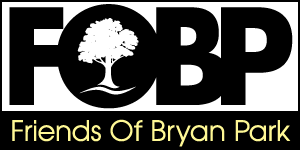Invasive Plants in Bryan Park
An invasive species is any living organism that is not native to an ecosystem and causes harm to its surroundings. Species that grow and reproduce quickly and spread aggressively, with potential to cause harm, are considered invasives. At Bryan Park our focus is on plants. Plants are spread by people, water, wind, and animals. Seeds can be included in packing materials or shipping containers and can travel the world.
One of our most invasive plants, Honeysuckle, Lonicera japonica, was brought to the US in the early 1900s and widely promoted as a beautiful, fast-growing vine. The flowers smell wonderful, it is mostly evergreen, and doesn’t require special care. In the year 2021, it would be considered a noxious weed in Virginia and other states. It grows over anything nearby, up into trees, crowds out the other plants, blocks the sunlight, and can kill trees and shrubs it surrounds.
We have a native honeysuckle, Lonicera sempervirens, but its growth habits cannot compete with the Asian variety.
Other invaders in Bryan Park include, but are not limited to:
Porcelain berry (vine)
Ivy or English ivy, Hedera helix (vine)
Kudzu (vine)
Ailanthus (tree)
Mimosa (tree)
Bradford pear (tree)
Wintercreeper(vine)
Privet (shrub, small tree)
Lesser celadine (groundcover)
Burning bush
Multiflora rose
bush honeysuckle
Knotweed
Invasives are found all over Bryan Park. Volunteers work diligently to remove these unwanted plants. In 2021, a formal strategy was implemented to remove invasives. Contractors were hired to address needs beyond the skill and reach of volunteers. Large invasive trees (Bradford pears, ailanthus, mimosa) require professional arborists for safe removal. Large areas overrun with honeysuckle and ivy require machine assistance with professional operators. Some infestations (lesser celadine) require herbicide use by certified professionals.
Goats were brought into the park to remove unwanted plants in selected area. Goats are excellent workers, demanding only to be paid in leaves and other greenery.
Volunteers will always be needed and appreciated. Hand removal is often the best method.
We welcome volunteers interested in learning about and removing invaders so our park remains a healthy ecosystem. To volunteer: Click Here
Learn more:
An excellent guide for "freeing trees" from invasive vines - urbanforestdweller.com/is-the-future-forested/
Invasive plants and the top ten worst invaders:
jamesriverpark.org/invasives/invasives-vs-natives.php#top10



